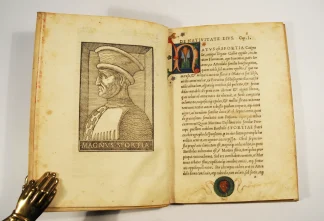GIOVIO, Paolo
Vita Sfortiae clariss. ducis
Rome, Antonio Blado, 1539£5,250.00
FIRST EDITION. 4to, ff. [4], 48, [4]; handsome italic letter; printer’s device on colophon, impressive woodcut portrait of Muzio Attendolo Sforza on aivv; light, mainly marginal, foxing and light waterstain at foot of central and final gatherings. A good, wide-margined copy in seventeenth-century Italian vellum; morocco title label on spine, a. e. marbled; wreathed contemporary coat of arms painted at foot of first leaf of text with probably later illuminated initials; tiny wormholes to spine; bookplate of the Alsatian philatelist Maurice Burrus (1882-1959) on front pastedown, two different faint earlier library stamps and later monogram stamp on blanks of title, the latter repeated on outer margin of f. xxv; on rear endpaper two labels with Maggs’ acquisition note from Lauria, 1938.
First edition of an early biographical work by a distinguished historian of the Italian Renaissance. Paolo Giovio (1483-1552) was a talented humanist, prelate and art collector; educated in Padua, he taught moral and natural philosophy at the University of Rome, acted as personal physician to pope Clement VII and was later appointed bishop of Nocera. His numerous writings enjoyed great success throughout Europe, embracing a vast range of subjects, from ancient and contemporary history to science, travel and emblems. This biography is devoted to the founder of the Sforza dynasty, Muzio Attendolo (1369-1424), whose powerful portrait appears in the book. A skilled condottiero, he served many Italian rulers, including pope Martin V, in the turbulent period marked by the wars against the expansion of the Milanese Duchy and the succession to the throne of Naples. His son Francesco (1401-1466) married Bianca Maria Visconti and managed to take over the Duchy of Milan from her family. The volume is dedicated to Cardinal Guido Ascanio Sforza, grandson of Paul III and illustrious member of the branch of the Sforza family stemming from another of Muzio Attendolo’s sons, Bosio (1410-1476), who settled in southern Tuscany to rule over the small independent county of Santa Fiora.
The coat of arms painted on f. 1r (red shield with gilt chevrons and three half moons) may well be that of a contemporary Italian family, like the Leonardi from Florence, who used silver-gilt chevrons and half moons.
BM STC It., 304; Adams, G 692; Brunet, 584; Graesse, III, 490; Mortimer, 212; Sander, 3170.In stock













